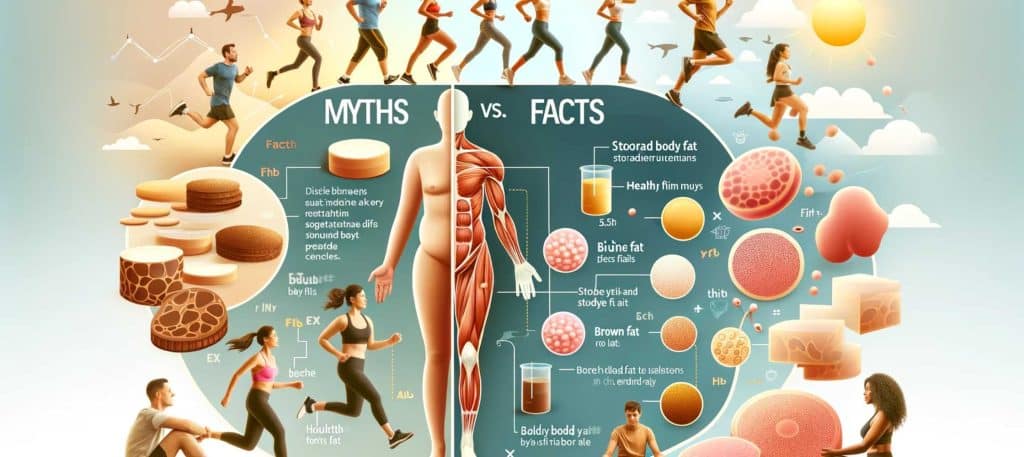|
Getting your Trinity Audio player ready...
|

In a world where health and fitness continuously capture public interest, the role of body fat, particularly storage body fat, often garners a wealth of attention—and an equal measure of misunderstanding.
While body fat is frequently portrayed in a negative light, its presence within the body is crucial for numerous biological functions.
Yet, myths and misconceptions about storage body fat abound, influencing how people manage their health and fitness goals. This blog aims to dispel some of these myths, providing a clearer picture of the true role and importance of body fat.
What is Storage Body Fat?
Storage body fat serves several essential functions in the human body, which are often overshadowed by the quest for weight loss.
Primarily, this type of fat acts as an energy reserve, stored in fat cells throughout the body and utilized when your energy intake is less than your energy expenditure. But the roles of storage body fat extend far beyond simply storing energy:
- Thermal Insulation: Fat helps to insulate the body, keeping us warm by trapping heat.
- Protection: It cushions and protects vital organs from shocks and injuries.
- Hormonal Function: Adipose tissue plays a critical role in hormone production, including hormones that regulate appetite, metabolism, and insulin sensitivity.
Distinguishing between the different types of body fat is also crucial:
- Subcutaneous Fat: Located under the skin, it makes up the majority of body fat.
- Visceral Fat: Found around internal organs, it has more significant implications for health.
- Brown Fat: Used primarily to generate heat, this type of fat is more prevalent in infants and decreases with age.
Common Myths About Storage Body Fat
One prevalent myth about storage body fat is its supposed significant influence on the aging process. This myth suggests that the mere presence of storage fat accelerates aging, which is a misunderstanding of both aging and the functions of fat in the body.
Myth 1: “Storage body fat significantly increases the effects of aging.”
Contrary to this belief, body fat itself does not cause accelerated aging. Instead, it is the excessive accumulation or the severe depletion of body fat that can lead to health problems, which may in turn influence one’s quality of life and longevity.
The key lies in balance and moderation. Properly managed body fat contributes to a healthy metabolic profile and can even protect against certain diseases by regulating body temperature and hormone levels.
Health Implications of Storage Body Fat
While body fat plays an essential role in maintaining good health, imbalances—either too much or too little—can lead to several health issues. Properly managed body fat is crucial, but deviations can disrupt the delicate balance of the body’s systems.
- Excess Body Fat: Carrying too much body fat, especially visceral fat, can contribute to various metabolic disorders, including insulin resistance, type 2 diabetes, and cardiovascular disease. The fat stored around the organs can interfere with normal hormonal functions and provoke inflammatory responses that predispose individuals to these conditions (Cleveland Clinic).
- Insufficient Body Fat: On the other end of the spectrum, too little body fat can be just as problematic. It can lead to hormonal imbalances, affect fertility, and diminish bone density, making individuals more susceptible to fractures and osteoporosis. The body’s ability to regulate temperature could also be impaired, leading to a host of other health issues.
Assessing Healthy Body Fat Levels
Understanding and assessing the right amount of body fat is vital for maintaining health. Body Mass Index (BMI) is commonly used as a basic gauge, but it has its limitations.
For instance, BMI does not differentiate between muscle and fat mass, often misclassifying muscular individuals as overweight or obese.
- BMI Calculation: BMI is calculated by dividing your weight in kilograms by your height in meters squared. It’s a quick screening tool, but not a diagnostic of the body fat amount or distribution.
- Waist Circumference: To complement BMI measurements, health professionals often recommend measuring waist circumference to assess abdominal fat. Women with a waist measurement of more than 35 inches and men more than 40 inches are at higher risk for developing obesity-related conditions.
- Waist-Hip Ratio: This measurement is another critical indicator of health risks related to body fat. A higher ratio indicates a higher risk of heart disease and type 2 diabetes, particularly if much of the weight is carried around the waist.
Managing Healthy Levels of Body Fat
Maintaining a healthy level of body fat is crucial for overall wellness and can be achieved through a balanced diet and regular exercise. Here are some practical tips for managing body fat:
- Diet: Opt for a balanced diet rich in vegetables, fruits, whole grains, and lean proteins. Limit the intake of sugars and saturated fats, which can contribute to the accumulation of unhealthy visceral fat.
- Exercise: Regular physical activity helps burn calories and reduce excess body fat. Aim for at least 150 minutes of moderate-intensity or 75 minutes of high-intensity exercise each week, as recommended by health guidelines.
- Lifestyle: Avoid sedentary behaviors by taking breaks during long periods of sitting, and try to incorporate more physical activity into your daily routine.
Conclusion
Storage body fat has a significant impact on our health, but it’s the balance that truly matters. By understanding the myths surrounding body fat, assessing our own body fat levels accurately, and managing them through informed lifestyle choices, we can enhance our health and well-being.
Remember, it’s not just about losing weight—it’s about maintaining the right amount of body fat to support your body’s natural functions and lead a healthy life. For personalized advice, always consult with a healthcare provider to create a plan that’s right for you.
- Debunking Myths About Storage Body Fat - May 2, 2024
- Is Fiji Water Good for You – Health and Environmental Guide - April 22, 2024
- Is Sparkling Ice Good for You? Health Insights Revealed - April 22, 2024
